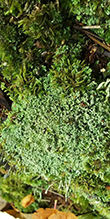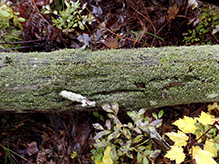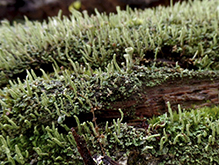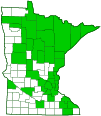Common Powderhorn
(Cladonia coniocraea)
Conservation • Description • Ecology • Distribution • Taxonomy
Conservation Status |
|
|||||||
| IUCN Red List | not listed |
|||||||
| NatureServe | NNR - Unranked |
|||||||
| Minnesota | not listed |
|||||||
Description |
||
Common Powderhorn is a widespread and very common lichen in Europe, Asia, and North America. In the United States it is found from the east coast to the Midwest, including Minnesota, on the west coast, and in the Rocky Mountains. It grows in the shade on decaying stumps and logs and often at the bases of trees. It rarely grows on bare ground. It is resistant to pollution and can be found in urban areas. Common Powderhorn produces two types of vegetative growth (thallus). The primary thallus is composed entirely of green to grayish-green, flat, overlapping, leaf-like scales (squamules) that adhere closely to the substrate. Each of these basal squamules is ⅛″ to ⅜″ long and 1 ⁄16″ to 3 ⁄16″ wide. The margins are always deeply incised and often lobed. The underside is white and lacks a layer of protective tissue (cortex). The margins and the underside are sparsely to densely covered with tiny granules (soredia). The secondary thallus is a green to grayish-green, slender, vertical stalk (podetium) that rises from the center of a basal squamule. The podetia is hollow, more or less curved, usually unbranched, 5 ⁄16″ to 1¾″ tall, and 1 ⁄32″ to 1 ⁄16″ wide. The tip is usually slender and tapers to a point. Rarely, it ends in a very small, 1 ⁄32″ to 1 ⁄16″ (1 to 2 mm) wide cup. The cortex is thin at the base becoming thinner as it approaches the top. It does not extend to the tip or to the interior of the cup. The upper two-thirds of the podetia is mealy due to a covering of soredia, and there are usually small squamules near the base. The disk-shaped reproductive structures (apothecia) common on many lichens are rarely produced by Common Powderhorn. When present, they are at the tip of the podetia, brown, and less than 1 ⁄16″ (1.0 to 1.5 mm) in diameter. |
||
Similar Species |
||
Smooth-footed Powderhorn (Cladonia ochrochlora) squamules may be almost entire, unlobed and not incised. Podetia are grayish, thicker, and often branched or twisted. Cups at the tip are usually present. The cortex of the podetia is thick and extends well above the base. |
||
Ecology |
||
Substrate |
||
Ground |
||
Growth Form |
||
Fruticose |
||
Habitat |
||
Decaying stumps and logs and often at the bases of trees |
||
Hosts |
||
|
||
Distribution |
||||
|
Sources |
|||
| 8/9/2022 | ||||
Occurrence |
||||
Widespread and very common |
||||
Taxonomy |
|||
| Kingdom | Fungi (fungi including lichens) | ||
| Subkingdom | Dikarya | ||
| Phylum | Ascomycota (Sac Fungi) | ||
| Subphylum | Pezizomycotina (Sac Fungi and Lichens) | ||
| Class | Lecanoromycetes (Common Lichens) | ||
| Subclass | Lecanoromycetidae (Shield Lichens, Sunburst Lichens, Rosette Lichens, and Allies) | ||
Order |
Lecanorales (shield lichens, rim lichens, and allies) | ||
Suborder |
Lecanorineae | ||
Family |
Cladoniaceae (spindles and structured lichens) | ||
Genus |
Cladonia (pixie cup and reindeer lichens) | ||
| Mycobiont | Cladonia coniocraea | ||
| Photobiont | |||
Synonyms |
|||
|
|||
Common Names |
|||
Bighorn Cladonia Common Powderhorn Common Powderhorn Lichen |
|||
Glossary
Apothecium
An open, disk-shaped or cup-shaped, reproductive structure, with spore sacs on the upper surface, that produces spores for the fungal partner of a lichen. Plural: apothecia.
Podetium
The hollow stalk of the fruiting body of lichens in the genus Cladonia. Plural: podetia.
Soredium
An asexual reproductive structure of a lichen in the form of a tiny dull granule on the thallus surface that can be easily brushed off. It consists of a cluster of algal cells (the photobiont) wrapped in fungal filaments (the mycobiont), but without an outer layer of protective tissue (cortex). Plural: soredia.
Squamules
On lichens: small, flat, often overlapping, leaf-like scales without a lower cortex. Adjective: squamulose
Thallus
The vegetative body of a lichen composed of both the alga and the fungus.
Visitor Photos |
|||||
Share your photo of this fungus. |
|||||
| This button not working for you? Simply email us at info@MinnesotaSeasons.com. Attach one or more photos and, if you like, a caption. |
|||||
Luciearl |
|||||
 |
|||||
 |
 |
||||
MinnesotaSeasons.com Photos |
|||||
|
|||||

Visitor Videos |
|||
Share your video of this fungus. |
|||
| This button not working for you? Simply email us at info@MinnesotaSeasons.com. Attach a video, a YouTube link, or a cloud storage link. |
|||
Other Videos |
|||

Created: 10/17/2018
Last Updated:





